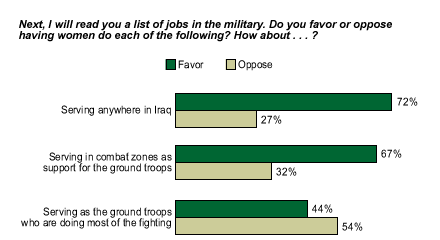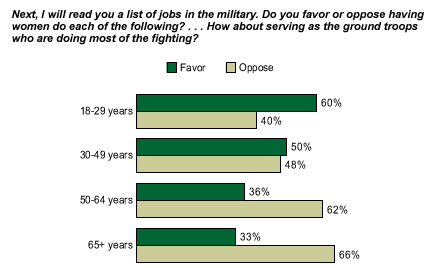After two weeks of intense House debate, a measure that sought to limit women's roles in active military combat was withdrawn late last month. Women are currently prohibited from serving in infantry, armor, and some artillery units, but serve in combat support units. The measure essentially would have forced the Army to strictly comply with a 1994 Pentagon policy barring female soldiers from direct ground combat below the brigade level. Senior Army leaders opposed the measure, citing the potential loss of at least 21,000 combat support-related jobs and confusion among troops serving in Iraq.
A recent CNN/USA Today/Gallup poll* shows that a majority of Americans support women serving in combat zones as support for ground troops and serving anywhere in Iraq. However, most oppose women serving as "ground troops who are doing most of the fighting."
The survey asked respondents about women serving in three different military roles. A substantial majority (72%) of Americans favor women "serving anywhere in Iraq." Two-thirds (67%) support women serving in combat zones as support for ground troops. But when asked about women "serving as ground troops who are doing most of the fighting," just 44% are in favor.

Who's Most Willing to Let Women Fight?
Women are slightly more likely than men to favor the idea of women serving as ground combat troops, 47% compared with 42%. The House measure that proposed limits on women's roles in combat was Republican-sponsored, and the poll finds Republican identifiers (37%) less likely to favor women serving as ground troops in combat than are independents (49%) or Democrats (47%).
Age is a particularly significant factor in American's views of whether women should serve as ground combat troops. The youngest American adults (those aged 18 to 29) are most likely to favor the idea of women participating in heavy fighting, and support decreases with age: 60% of 18- to 29-year-olds favor the idea, as do half (50%) of 30- to 49-year-olds, 36% of those aged 50 to 64, and only 33% of people aged 65 and older. The age differences could reflect the changes in women's roles in recent military conflicts -- which is what younger Americans have only known -- or a tendency among younger Americans to be more liberal.

The data also show similar age differences in regard to views of whether women should serve in combat zones in a supporting role or serve in Iraq.
*Results are based on telephone interviews with 1,006 national adults, aged 18 and older, conducted May 20-22, 2005. For results based on the total sample of national adults, one can say with 95% confidence that the maximum margin of sampling error is ±3 percentage points. In addition to sampling error, question wording and practical difficulties in conducting surveys can introduce error or bias into the findings of public opinion polls.
